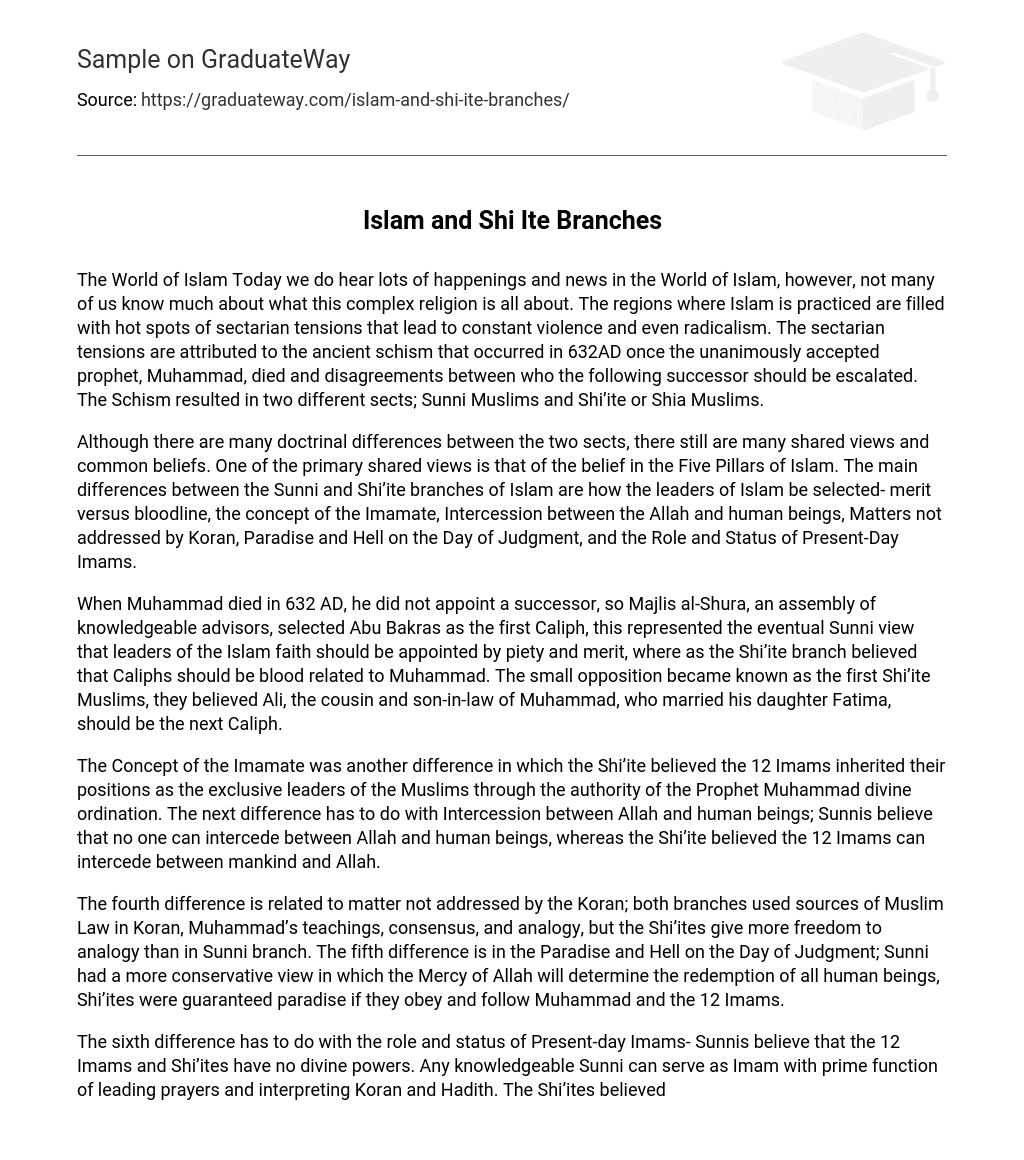The World of Islam Today we do hear lots of happenings and news in the World of Islam, however, not many of us know much about what this complex religion is all about. The regions where Islam is practiced are filled with hot spots of sectarian tensions that lead to constant violence and even radicalism. The sectarian tensions are attributed to the ancient schism that occurred in 632AD once the unanimously accepted prophet, Muhammad, died and disagreements between who the following successor should be escalated. The Schism resulted in two different sects; Sunni Muslims and Shi’ite or Shia Muslims.
Although there are many doctrinal differences between the two sects, there still are many shared views and common beliefs. One of the primary shared views is that of the belief in the Five Pillars of Islam. The main differences between the Sunni and Shi’ite branches of Islam are how the leaders of Islam be selected- merit versus bloodline, the concept of the Imamate, Intercession between the Allah and human beings, Matters not addressed by Koran, Paradise and Hell on the Day of Judgment, and the Role and Status of Present-Day Imams.
When Muhammad died in 632 AD, he did not appoint a successor, so Majlis al-Shura, an assembly of knowledgeable advisors, selected Abu Bakras as the first Caliph, this represented the eventual Sunni view that leaders of the Islam faith should be appointed by piety and merit, where as the Shi’ite branch believed that Caliphs should be blood related to Muhammad. The small opposition became known as the first Shi’ite Muslims, they believed Ali, the cousin and son-in-law of Muhammad, who married his daughter Fatima, should be the next Caliph.
The Concept of the Imamate was another difference in which the Shi’ite believed the 12 Imams inherited their positions as the exclusive leaders of the Muslims through the authority of the Prophet Muhammad divine ordination. The next difference has to do with Intercession between Allah and human beings; Sunnis believe that no one can intercede between Allah and human beings, whereas the Shi’ite believed the 12 Imams can intercede between mankind and Allah.
The fourth difference is related to matter not addressed by the Koran; both branches used sources of Muslim Law in Koran, Muhammad’s teachings, consensus, and analogy, but the Shi’ites give more freedom to analogy than in Sunni branch. The fifth difference is in the Paradise and Hell on the Day of Judgment; Sunni had a more conservative view in which the Mercy of Allah will determine the redemption of all human beings, Shi’ites were guaranteed paradise if they obey and follow Muhammad and the 12 Imams.
The sixth difference has to do with the role and status of Present-day Imams- Sunnis believe that the 12 Imams and Shi’ites have no divine powers. Any knowledgeable Sunni can serve as Imam with prime function of leading prayers and interpreting Koran and Hadith. The Shi’ites believed the highest ranking present-day Imams could receive their guidance and spiritual enlightenment directly from the “Twelve Imams” who are in contact with their followers through contemporary spiritual leaders. Next, Shi’ites have a more elaborate religious hierarchy, and less of a need to rely on secular grants for money.
Religious officials make appointments to senior positions in the Shi’ite branch, whereas in the Sunni branch senior positions are made by the States. Finally, there are significant geographic differences between the two branches; Sunni are the majority in Saudi Arabia, Egypt, Yemen, Pakistan, Indonesia, Turkey, and Algeria. Shi’ite are the majority only in Iraq, Iran, Bahrain, Azerbaijan, with sizeable minorities in Afghanistan, Kuwait, Lebanon, Pakistan, Saudi Arabia, Yemen, and Kuwait. The main similarities between the Sunni and Shi’ite branches of Islam are rooted back to the early days of the religion, and general views.
All Muslims believe that Allah chose Muhammad as the Prophet of Islam; they agree that with Allah’s blessings and continuous revelations, that Muhammad guided Muslims to lead life according to the Koran, and lead life according to the Hadith (Muhammad’s teaching and sayings based on ethics). Both Sunni and Shi’ite Muslims believe that piety, righteous observance of principles of the Koran and that striving for goodness in daily life are the greatest virtues of human beings. They believe that social justice is a fundamental right.
Finally, all Muslims agree on a strong ethical and moral code to regulate human behavior in all its manifestations. Another huge similarity between the Sunni and Shi’ite branches of Islam is the belief in the Five Pillars of Islam- what the Muslim faith is built upon. The First Pillar is the Shahabad, or the profession of faith. This pillar states the unity of Allah and the prophet hood of Muhammad; sent by Allah to organize their people on the basis of the guidance revealed by God (along with Noah, Abraham, Moses, and Jesus).
The Second Pillar is daily worship or Salat, obligatory five times a day (at dawn, midday, afternoon, evening, and night). The Third Pillar is the required “alms-levy” or Zakat, the obligation to share what one possesses with the less fortunate. Although Zakat has been left to individuals’ consciences, obligation to contribute to general welfare is continuously stressed. The Fourth Pillar is fasting during the month of Ramadan. Muslims are prohibited from eating, drinking, smoking, and sexual activities from dawn until dusk. The Fifth Pillar is the pilgrimage to Mecca, or Hajj, required once (if possible) in all Muslims lives.
The Islam World does spread out across many countries, and differences are many but ultimately the fundamental basis of the different branches is quite similar. The teachings of Muhammad, which only went on for 22 short years have significantly impacted the religion today. The Five Pillars of Islam can be seen as the primary similarity between the two branches, a shared set of guidelines all Muslims lead their lives by. Unfortunately despite the underlying similarities, the differences can be over-powering leading to many conflicts that frequently escalate quickly.





